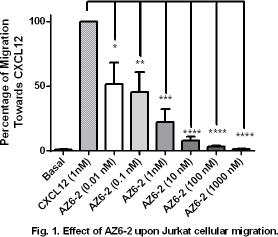Print version
Search Pub Med
| 002P Nottingham, UK 7th Focused Meeting on Cell Signalling |
Investigations into novel antagonists of the chemokine receptor CXCR4 to prevent the migration of cancerous cells
Introduction: Tumor metastasis is the cause of 90% of deaths in cancer patients1. One mediator of this is the chemokine family and their cognate receptors such as CXCR4, the most commonly overexpressed chemokine receptor on tumor cells2. The development of therapeutic CXCR4 antagonists could slow down the process of metastasis. The aim of this study was to investigate whether three novel CXCR4 antagonists, Ac-Arg-Ala-[Cys-Arg-Phe-Phe-Cys]-COOH (AZ3-2), Ac-Arg-Ala-[DCys-Arg-Phe-Phe-Cys]-COOH (AZ6-2)3 and AZ9-2 are more effective at inhibiting CXCR4 than the licensed CXCR4 antagonist AMD3100/Plerixafor.
Method: Chemotaxis: Two leukemic cell lines, Jurkat and THP-1, were harvested and incubated with either AZ3-2, AZ6-2, AZ9-2 or AMD3100. 25-50 x 104 cells were loaded onto a chemotaxis plate and stimulated with 1-5 nM CXCL12 for 5 hours. Migrating cells were counted using a haemocytometer. Calcium release assay: Jurkat, THP-1 and the breast cancer cell line MCF-7 cells were harvested and loaded with 1 μM of either AZ3-2, AZ6-2 or AMD3100 and 4 μM Fura-2AM at 37°C for 30 minutes. Cells were resuspended at a density of 2×106 cells/mL and analysed using a BMG Labtech Flurostar OPTIMA fluorometer. MTS assays: Jurkat cells were seeded into 96 well plates at a density of 5×105 cells/mL and incubated with a range of different concentrations of the test compounds for 72 hours and assessed using MTS reagent (Promega). Analysis was performed using one-way AVONA using GraphPad Prism.
Results: AZ3-2, AZ9-2 and AMD3100 (at 1000 nM and 100 nM) significantly blocked cellular migration in both THP-1 and Jurkat cell lines (n=3/4), while AZ6-2 caused significant reduction in cellular migration at much lower doses (0.01 nM to 1000 nM) (n=4, Fig. 1, Table 1). Additionally, calcium flux assays demonstrated that AZ6-2 and AMD3100 significantly inhibited calcium release in Jurkat and MCF-7 cells but AMD3100 does not block calcium release in THP-1 cells. These results are not due to the compounds exhibiting any cell toxicity, as determined by cell proliferation assays in Jurkat cells.


Conclusion: All four compounds caused a decrease in cellular migration with only the novel CXCR4 antagonist, AZ6-2 inhibiting calcium release across all cell lines.
References:
1. Mehlen P. and Puisieux A (2006). Nat Rev Cancer 6(6): 449-458.
2. Salazar N et al .(2013). Crit Rev Eukaryot Gene Expr 23(1).
3. Di Maro S et al. (2016). J Med Chem 59(18): 8369-8380.

